Docker / Kubernetes - ArgoCD on Kubernetes cluster
ArgoCD follows the GitOps pattern of using Git repositories as the source of truth for defining the desired application state. In other words, the ArgoCD automatically synchronize the cluster to the desired state defined in a Git repository.
Each workload is defined declarative through a resource manifest in a YAML file. Argo CD checks if the state defined in the Git repository matches what is running on the cluster and synchronizes it if changes were detected.
Kubernetes manifests can be specified in several ways:
- Kustomize applications
- Helm Charts
- Plain directory of YAML/json manifests
In this post, we'll use #3 (simple yamls) and they will be deployed to a Minikube cluster.
ArgoCD project can be found at https://github.com/argoproj/argo-cd.
Create a separate namespace for ArgoCD:
$ kubectl create namespace argocd namespace/argocd created $ kubectl get ns NAME STATUS AGE argocd Active 3s default Active 4d19h kube-node-lease Active 4d19h kube-public Active 4d19h kube-system Active 4d19h
Then, we can install ArgoCD into the argocd namespace:
$ kubectl apply -n argocd -f https://raw.githubusercontent.com/argoproj/argo-cd/master/manifests/install.yaml $ kubectl get all -n argocd NAME READY STATUS RESTARTS AGE pod/argocd-application-controller-0 1/1 Running 0 34m pod/argocd-dex-server-567b48df49-4dd7p 1/1 Running 0 34m pod/argocd-redis-6fb68d9df5-xs4rz 1/1 Running 0 34m pod/argocd-repo-server-6dcbd9cb-8nhmp 1/1 Running 0 34m pod/argocd-server-69678b4f65-xrddw 1/1 Running 0 34m NAME TYPE CLUSTER-IP EXTERNAL-IP PORT(S) AGE service/argocd-dex-server ClusterIP 10.110.134.70 <none> 5556/TCP,5557/TCP,5558/TCP 34m service/argocd-metrics ClusterIP 10.104.185.89 <none> 8082/TCP 34m service/argocd-redis ClusterIP 10.111.92.240 <none> 6379/TCP 34m service/argocd-repo-server ClusterIP 10.100.192.39 <none> 8081/TCP,8084/TCP 34m service/argocd-server ClusterIP 10.99.48.85 <none> 80/TCP,443/TCP 34m service/argocd-server-metrics ClusterIP 10.103.236.26 <none> 8083/TCP 34m NAME READY UP-TO-DATE AVAILABLE AGE deployment.apps/argocd-dex-server 1/1 1 1 34m deployment.apps/argocd-redis 1/1 1 1 34m deployment.apps/argocd-repo-server 1/1 1 1 34m deployment.apps/argocd-server 1/1 1 1 34m NAME DESIRED CURRENT READY AGE replicaset.apps/argocd-dex-server-567b48df49 1 1 1 34m replicaset.apps/argocd-redis-6fb68d9df5 1 1 1 34m replicaset.apps/argocd-repo-server-6dcbd9cb 1 1 1 34m replicaset.apps/argocd-server-69678b4f65 1 1 1 34m NAME READY AGE statefulset.apps/argocd-application-controller 1/1 34m
Once the pods are ready, ArgoCD will be running. But the ArgoCD API server will not be accessible from outside the cluster. We'll use port-forward to expose a port to the service, and forward it to localhost:
$ kubectl port-forward svc/argocd-server -n argocd 8080:443 Forwarding from 127.0.0.1:8080 -> 8080 Forwarding from [::1]:8080 -> 8080
Now we'll be able to access the API server via localhost:8080:
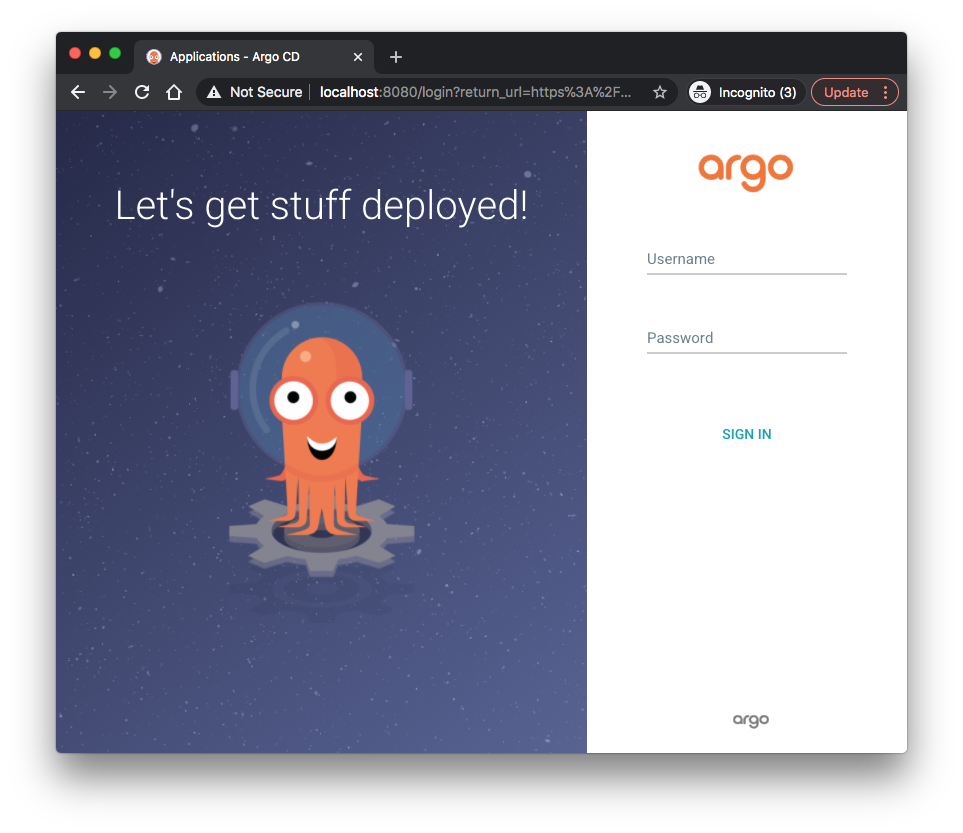
The username for Argo CD is admin and the initial password is autogenerated. The initial password is usually the pod name of the Argo CD server:
$ kubectl get pod -n argocd NAME READY STATUS RESTARTS AGE argocd-application-controller-0 1/1 Running 0 6m7s argocd-dex-server-567b48df49-4dd7p 1/1 Running 0 6m9s argocd-redis-6fb68d9df5-xs4rz 1/1 Running 0 6m9s argocd-repo-server-6dcbd9cb-8nhmp 1/1 Running 0 6m8s argocd-server-69678b4f65-xrddw 1/1 Running 0 6m8s
So, in our case, username = admin and password = argocd-server-69678b4f65-xrddw. Login with the credentials.
Now we want to create an application for our project on ArgoCD.
After the login, click the Manage your repositories in the left panel:
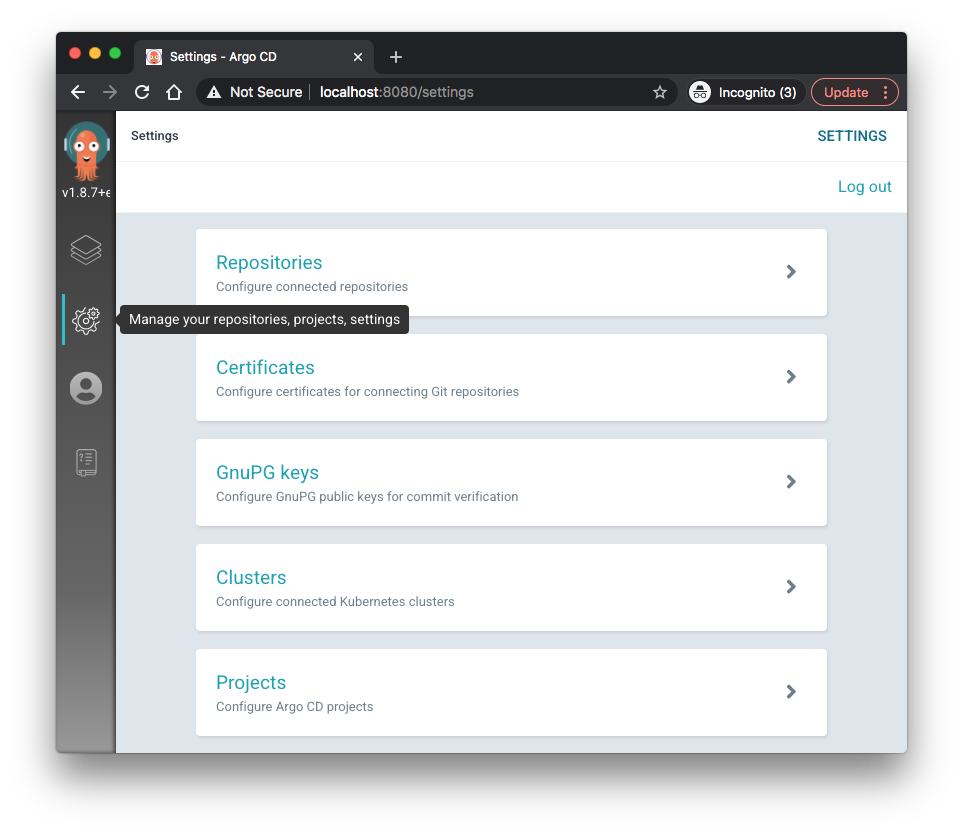
Then click Repositories.
We can use either HTTPS or SSH link to connect our repository to ArgoCD:
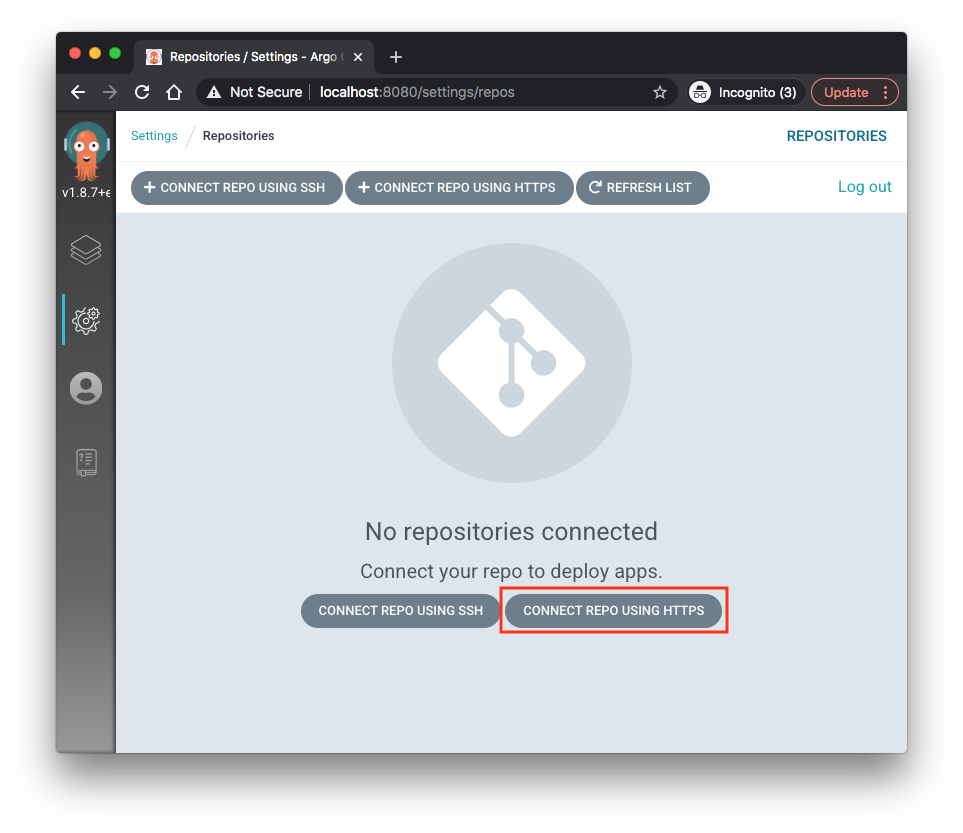
For a public repository, we just add the repo URL:
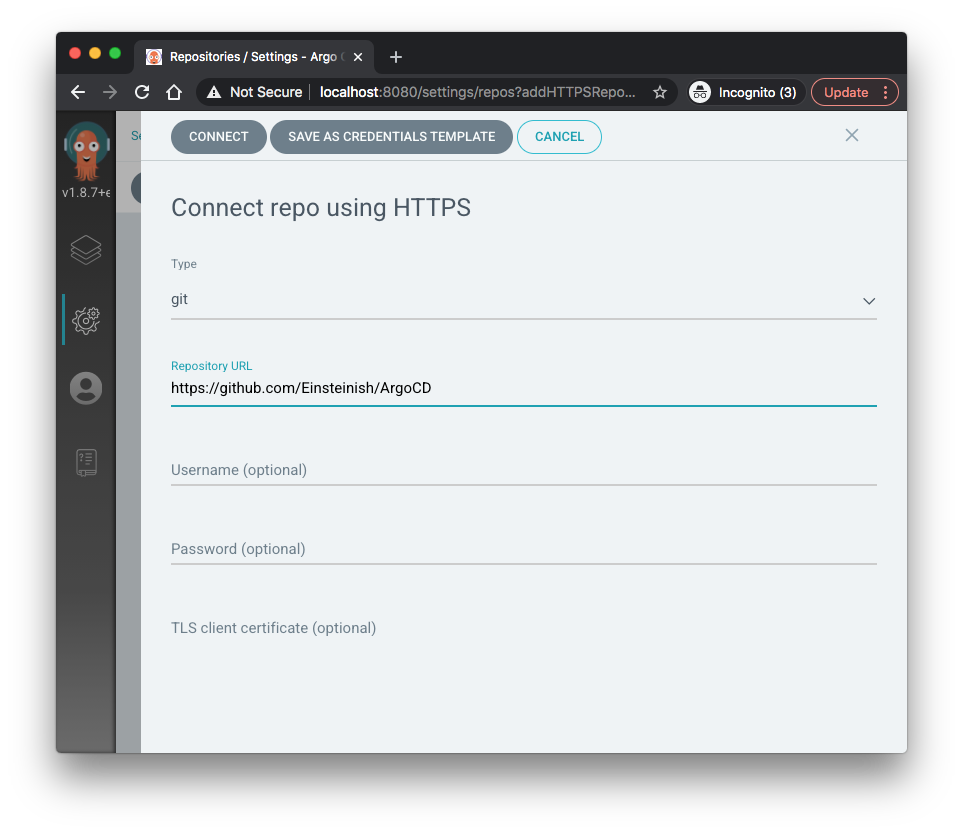
It's pointing to the githubrepo:
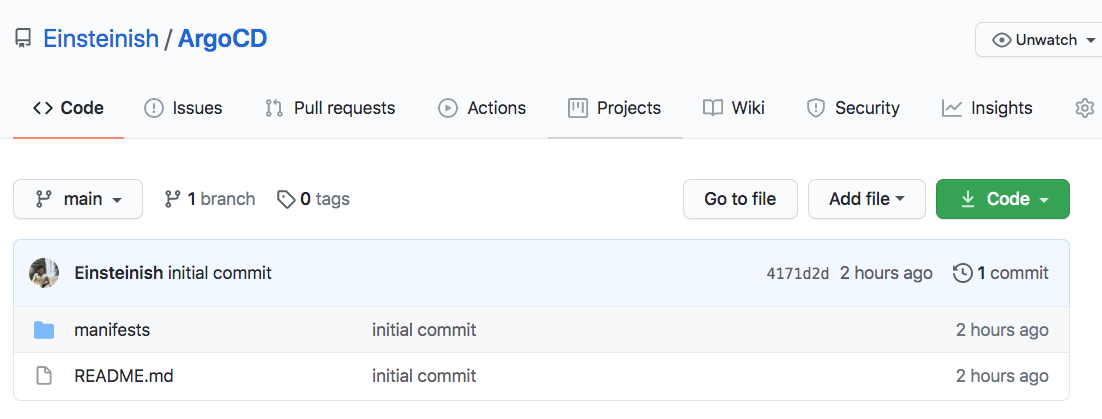
Click "Connect":
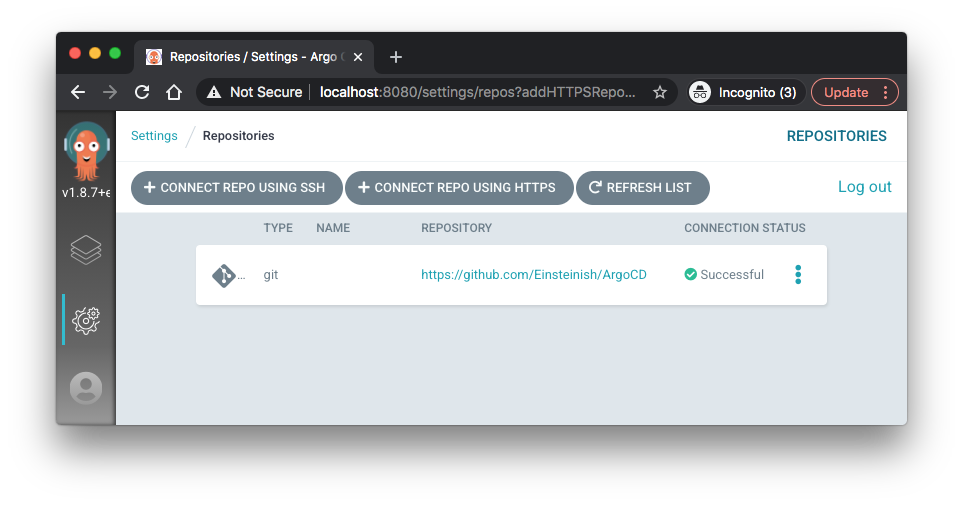
Once connected to the github, go the "Application":
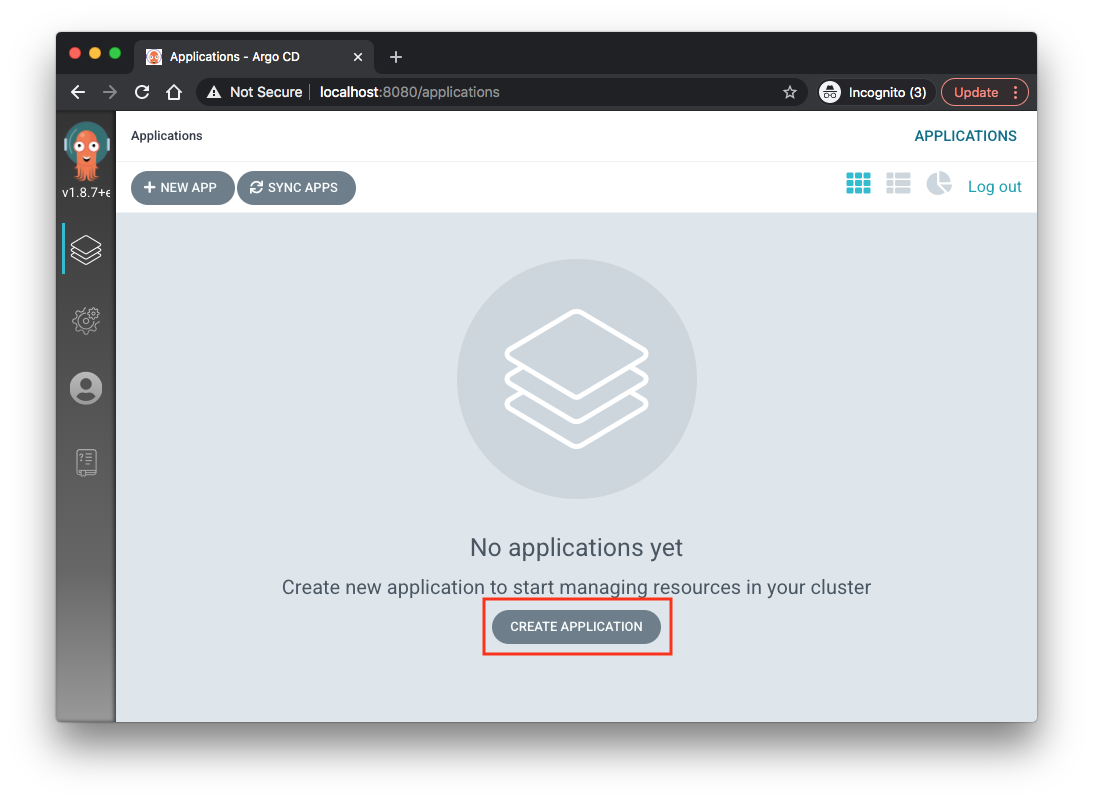
Fill out the necessary fields:
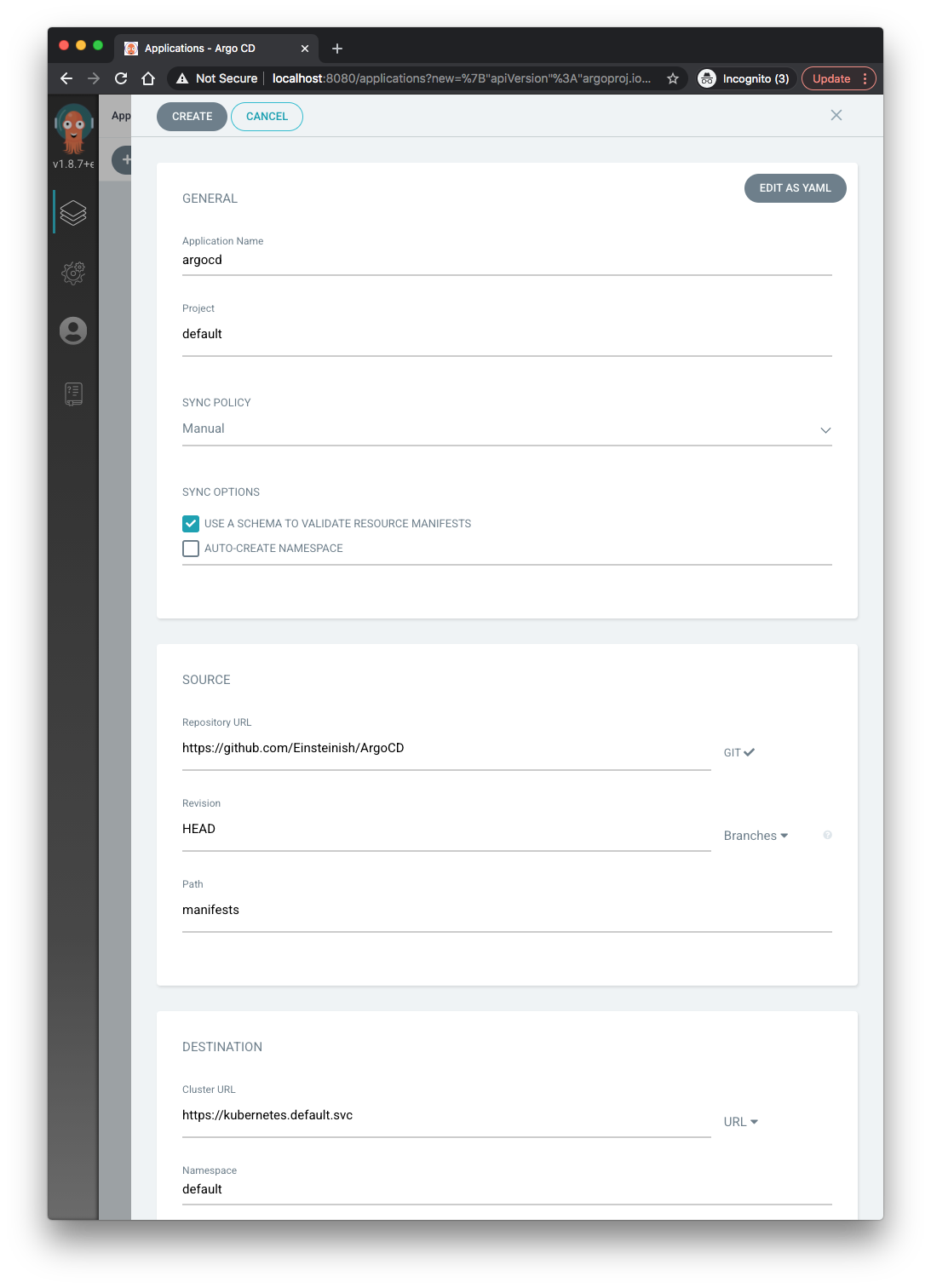
Once we filled all the required details, click "CREATE" and we'll be able to see our application:
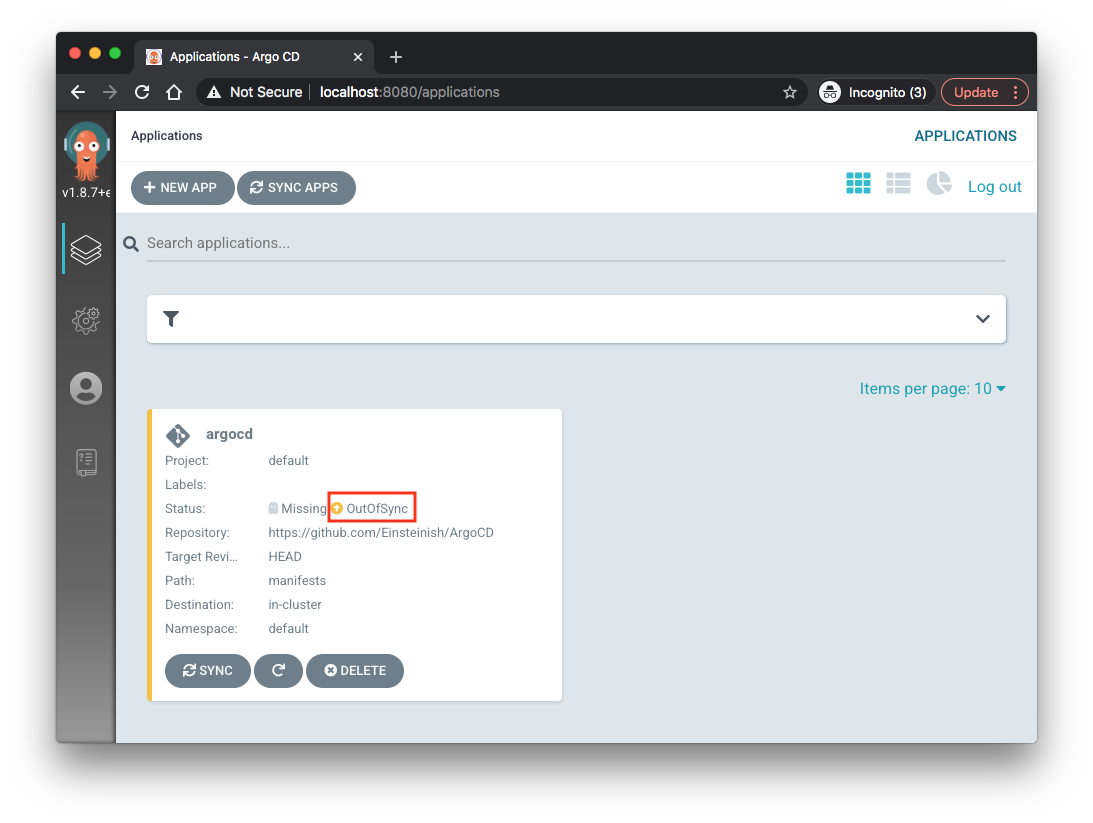
Click the "OutOfSync" and we see the details:
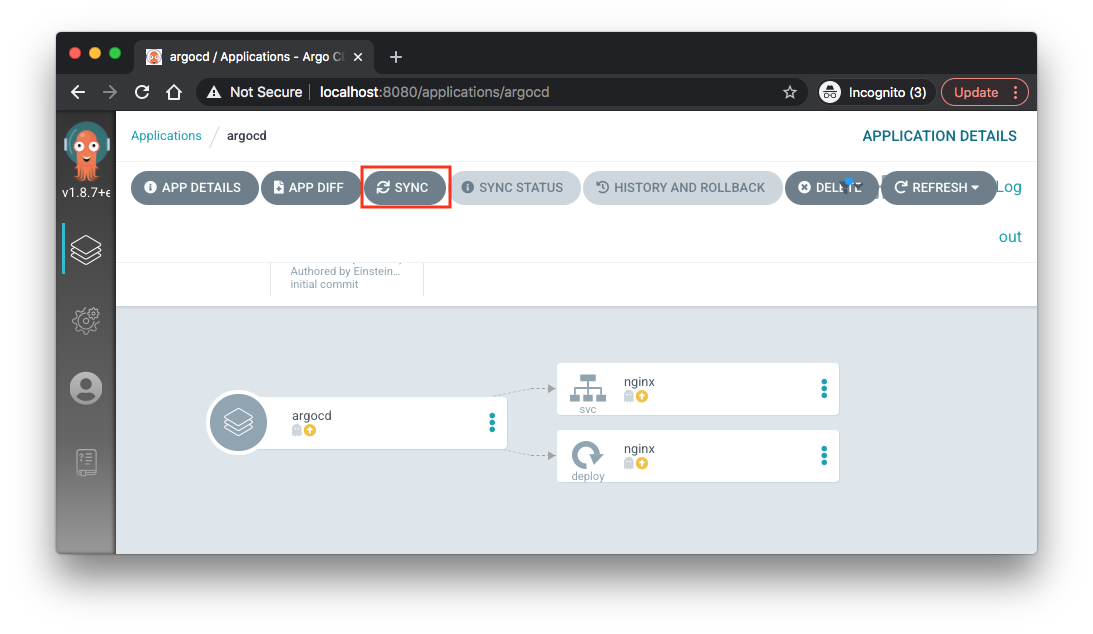
Click the "SYNC" and we'll get an output below, and then click "SYNCHRONIZE":
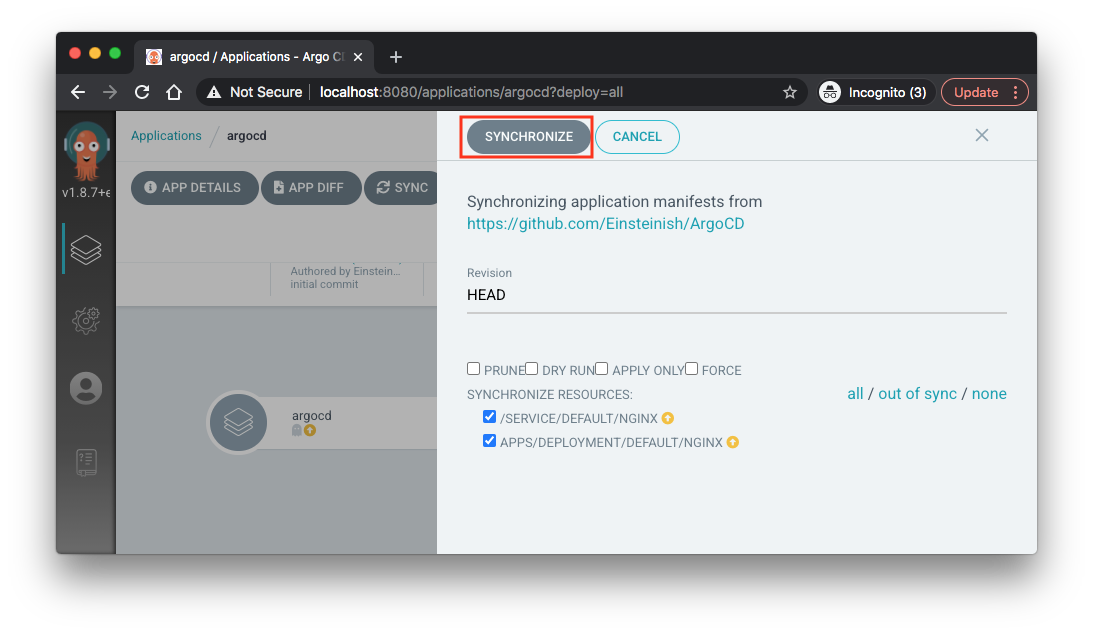
It will start syncing and it takes some time to complete the process. Once i'’s done our app should look like this:
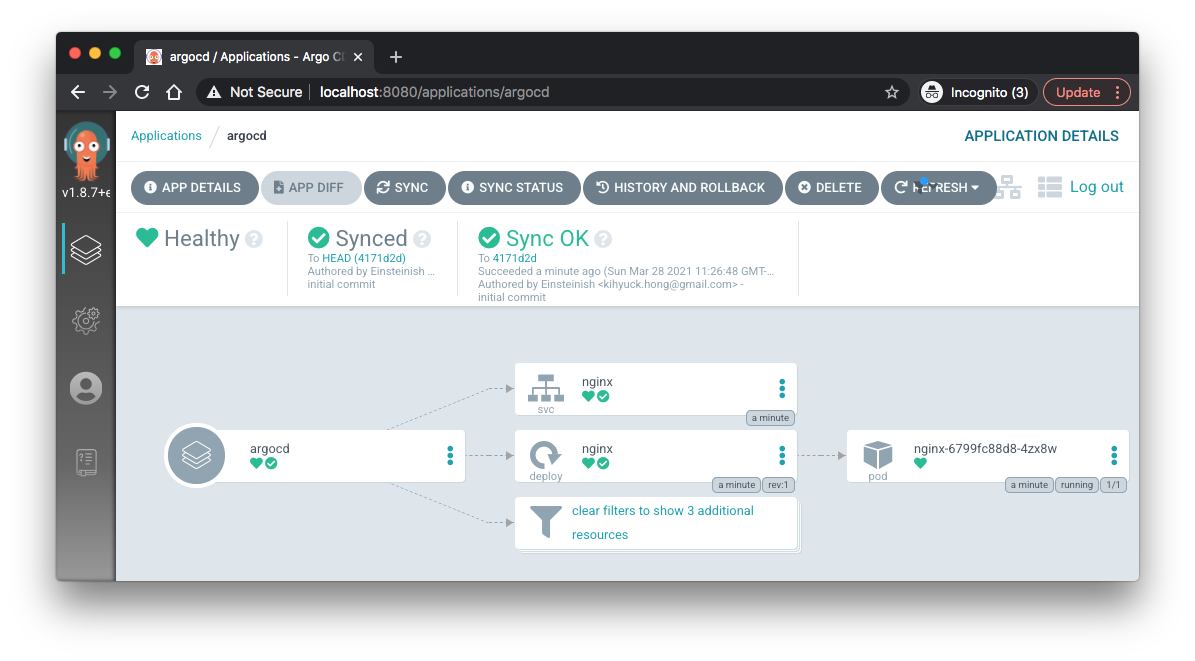
$ kubectl get all NAME READY STATUS RESTARTS AGE pod/nginx-6799fc88d8-4zx8w 1/1 Running 0 6m32s NAME TYPE CLUSTER-IP EXTERNAL-IP PORT(S) AGE service/kubernetes ClusterIP 10.96.0.1 <none> 443/TCP 16h service/nginx NodePort 10.96.35.252 <none> 80:31555/TCP 6m33s NAME READY UP-TO-DATE AVAILABLE AGE deployment.apps/nginx 1/1 1 1 6m32s NAME DESIRED CURRENT READY AGE replicaset.apps/nginx-6799fc88d8 1 1 1 6m32s
Now that our pod and service are in place, let's access the nginx app:
$ minikube service nginx |-----------|-------|-------------|-------------------------| | NAMESPACE | NAME | TARGET PORT | URL | |-----------|-------|-------------|-------------------------| | default | nginx | 80 | http://172.17.0.3:31555 | |-----------|-------|-------------|-------------------------| Starting tunnel for service nginx. |-----------|-------|-------------|------------------------| | NAMESPACE | NAME | TARGET PORT | URL | |-----------|-------|-------------|------------------------| | default | nginx | | http://127.0.0.1:64462 | |-----------|-------|-------------|------------------------| Opening service default/nginx in default browser... Because you are using a Docker driver on darwin, the terminal needs to be open to run it.

We may want to play more since there are lots of additional features. For example, in the demo, we used "Manual" sync policy but we want to try "Automatic" sync policy as well!
Docker & K8s
- Docker install on Amazon Linux AMI
- Docker install on EC2 Ubuntu 14.04
- Docker container vs Virtual Machine
- Docker install on Ubuntu 14.04
- Docker Hello World Application
- Nginx image - share/copy files, Dockerfile
- Working with Docker images : brief introduction
- Docker image and container via docker commands (search, pull, run, ps, restart, attach, and rm)
- More on docker run command (docker run -it, docker run --rm, etc.)
- Docker Networks - Bridge Driver Network
- Docker Persistent Storage
- File sharing between host and container (docker run -d -p -v)
- Linking containers and volume for datastore
- Dockerfile - Build Docker images automatically I - FROM, MAINTAINER, and build context
- Dockerfile - Build Docker images automatically II - revisiting FROM, MAINTAINER, build context, and caching
- Dockerfile - Build Docker images automatically III - RUN
- Dockerfile - Build Docker images automatically IV - CMD
- Dockerfile - Build Docker images automatically V - WORKDIR, ENV, ADD, and ENTRYPOINT
- Docker - Apache Tomcat
- Docker - NodeJS
- Docker - NodeJS with hostname
- Docker Compose - NodeJS with MongoDB
- Docker - Prometheus and Grafana with Docker-compose
- Docker - StatsD/Graphite/Grafana
- Docker - Deploying a Java EE JBoss/WildFly Application on AWS Elastic Beanstalk Using Docker Containers
- Docker : NodeJS with GCP Kubernetes Engine
- Docker : Jenkins Multibranch Pipeline with Jenkinsfile and Github
- Docker : Jenkins Master and Slave
- Docker - ELK : ElasticSearch, Logstash, and Kibana
- Docker - ELK 7.6 : Elasticsearch on Centos 7
- Docker - ELK 7.6 : Filebeat on Centos 7
- Docker - ELK 7.6 : Logstash on Centos 7
- Docker - ELK 7.6 : Kibana on Centos 7
- Docker - ELK 7.6 : Elastic Stack with Docker Compose
- Docker - Deploy Elastic Cloud on Kubernetes (ECK) via Elasticsearch operator on minikube
- Docker - Deploy Elastic Stack via Helm on minikube
- Docker Compose - A gentle introduction with WordPress
- Docker Compose - MySQL
- MEAN Stack app on Docker containers : micro services
- MEAN Stack app on Docker containers : micro services via docker-compose
- Docker Compose - Hashicorp's Vault and Consul Part A (install vault, unsealing, static secrets, and policies)
- Docker Compose - Hashicorp's Vault and Consul Part B (EaaS, dynamic secrets, leases, and revocation)
- Docker Compose - Hashicorp's Vault and Consul Part C (Consul)
- Docker Compose with two containers - Flask REST API service container and an Apache server container
- Docker compose : Nginx reverse proxy with multiple containers
- Docker & Kubernetes : Envoy - Getting started
- Docker & Kubernetes : Envoy - Front Proxy
- Docker & Kubernetes : Ambassador - Envoy API Gateway on Kubernetes
- Docker Packer
- Docker Cheat Sheet
- Docker Q & A #1
- Kubernetes Q & A - Part I
- Kubernetes Q & A - Part II
- Docker - Run a React app in a docker
- Docker - Run a React app in a docker II (snapshot app with nginx)
- Docker - NodeJS and MySQL app with React in a docker
- Docker - Step by Step NodeJS and MySQL app with React - I
- Installing LAMP via puppet on Docker
- Docker install via Puppet
- Nginx Docker install via Ansible
- Apache Hadoop CDH 5.8 Install with QuickStarts Docker
- Docker - Deploying Flask app to ECS
- Docker Compose - Deploying WordPress to AWS
- Docker - WordPress Deploy to ECS with Docker-Compose (ECS-CLI EC2 type)
- Docker - WordPress Deploy to ECS with Docker-Compose (ECS-CLI Fargate type)
- Docker - ECS Fargate
- Docker - AWS ECS service discovery with Flask and Redis
- Docker & Kubernetes : minikube
- Docker & Kubernetes 2 : minikube Django with Postgres - persistent volume
- Docker & Kubernetes 3 : minikube Django with Redis and Celery
- Docker & Kubernetes 4 : Django with RDS via AWS Kops
- Docker & Kubernetes : Kops on AWS
- Docker & Kubernetes : Ingress controller on AWS with Kops
- Docker & Kubernetes : HashiCorp's Vault and Consul on minikube
- Docker & Kubernetes : HashiCorp's Vault and Consul - Auto-unseal using Transit Secrets Engine
- Docker & Kubernetes : Persistent Volumes & Persistent Volumes Claims - hostPath and annotations
- Docker & Kubernetes : Persistent Volumes - Dynamic volume provisioning
- Docker & Kubernetes : DaemonSet
- Docker & Kubernetes : Secrets
- Docker & Kubernetes : kubectl command
- Docker & Kubernetes : Assign a Kubernetes Pod to a particular node in a Kubernetes cluster
- Docker & Kubernetes : Configure a Pod to Use a ConfigMap
- AWS : EKS (Elastic Container Service for Kubernetes)
- Docker & Kubernetes : Run a React app in a minikube
- Docker & Kubernetes : Minikube install on AWS EC2
- Docker & Kubernetes : Cassandra with a StatefulSet
- Docker & Kubernetes : Terraform and AWS EKS
- Docker & Kubernetes : Pods and Service definitions
- Docker & Kubernetes : Service IP and the Service Type
- Docker & Kubernetes : Kubernetes DNS with Pods and Services
- Docker & Kubernetes : Headless service and discovering pods
- Docker & Kubernetes : Scaling and Updating application
- Docker & Kubernetes : Horizontal pod autoscaler on minikubes
- Docker & Kubernetes : From a monolithic app to micro services on GCP Kubernetes
- Docker & Kubernetes : Rolling updates
- Docker & Kubernetes : Deployments to GKE (Rolling update, Canary and Blue-green deployments)
- Docker & Kubernetes : Slack Chat Bot with NodeJS on GCP Kubernetes
- Docker & Kubernetes : Continuous Delivery with Jenkins Multibranch Pipeline for Dev, Canary, and Production Environments on GCP Kubernetes
- Docker & Kubernetes : NodePort vs LoadBalancer vs Ingress
- Docker & Kubernetes : MongoDB / MongoExpress on Minikube
- Docker & Kubernetes : Load Testing with Locust on GCP Kubernetes
- Docker & Kubernetes : MongoDB with StatefulSets on GCP Kubernetes Engine
- Docker & Kubernetes : Nginx Ingress Controller on Minikube
- Docker & Kubernetes : Setting up Ingress with NGINX Controller on Minikube (Mac)
- Docker & Kubernetes : Nginx Ingress Controller for Dashboard service on Minikube
- Docker & Kubernetes : Nginx Ingress Controller on GCP Kubernetes
- Docker & Kubernetes : Kubernetes Ingress with AWS ALB Ingress Controller in EKS
- Docker & Kubernetes : Setting up a private cluster on GCP Kubernetes
- Docker & Kubernetes : Kubernetes Namespaces (default, kube-public, kube-system) and switching namespaces (kubens)
- Docker & Kubernetes : StatefulSets on minikube
- Docker & Kubernetes : RBAC
- Docker & Kubernetes Service Account, RBAC, and IAM
- Docker & Kubernetes - Kubernetes Service Account, RBAC, IAM with EKS ALB, Part 1
- Docker & Kubernetes : Helm Chart
- Docker & Kubernetes : My first Helm deploy
- Docker & Kubernetes : Readiness and Liveness Probes
- Docker & Kubernetes : Helm chart repository with Github pages
- Docker & Kubernetes : Deploying WordPress and MariaDB with Ingress to Minikube using Helm Chart
- Docker & Kubernetes : Deploying WordPress and MariaDB to AWS using Helm 2 Chart
- Docker & Kubernetes : Deploying WordPress and MariaDB to AWS using Helm 3 Chart
- Docker & Kubernetes : Helm Chart for Node/Express and MySQL with Ingress
- Docker & Kubernetes : Deploy Prometheus and Grafana using Helm and Prometheus Operator - Monitoring Kubernetes node resources out of the box
- Docker & Kubernetes : Deploy Prometheus and Grafana using kube-prometheus-stack Helm Chart
- Docker & Kubernetes : Istio (service mesh) sidecar proxy on GCP Kubernetes
- Docker & Kubernetes : Istio on EKS
- Docker & Kubernetes : Istio on Minikube with AWS EC2 for Bookinfo Application
- Docker & Kubernetes : Deploying .NET Core app to Kubernetes Engine and configuring its traffic managed by Istio (Part I)
- Docker & Kubernetes : Deploying .NET Core app to Kubernetes Engine and configuring its traffic managed by Istio (Part II - Prometheus, Grafana, pin a service, split traffic, and inject faults)
- Docker & Kubernetes : Helm Package Manager with MySQL on GCP Kubernetes Engine
- Docker & Kubernetes : Deploying Memcached on Kubernetes Engine
- Docker & Kubernetes : EKS Control Plane (API server) Metrics with Prometheus
- Docker & Kubernetes : Spinnaker on EKS with Halyard
- Docker & Kubernetes : Continuous Delivery Pipelines with Spinnaker and Kubernetes Engine
- Docker & Kubernetes : Multi-node Local Kubernetes cluster : Kubeadm-dind (docker-in-docker)
- Docker & Kubernetes : Multi-node Local Kubernetes cluster : Kubeadm-kind (k8s-in-docker)
- Docker & Kubernetes : nodeSelector, nodeAffinity, taints/tolerations, pod affinity and anti-affinity - Assigning Pods to Nodes
- Docker & Kubernetes : Jenkins-X on EKS
- Docker & Kubernetes : ArgoCD App of Apps with Heml on Kubernetes
- Docker & Kubernetes : ArgoCD on Kubernetes cluster
- Docker & Kubernetes : GitOps with ArgoCD for Continuous Delivery to Kubernetes clusters (minikube) - guestbook
Ph.D. / Golden Gate Ave, San Francisco / Seoul National Univ / Carnegie Mellon / UC Berkeley / DevOps / Deep Learning / Visualization